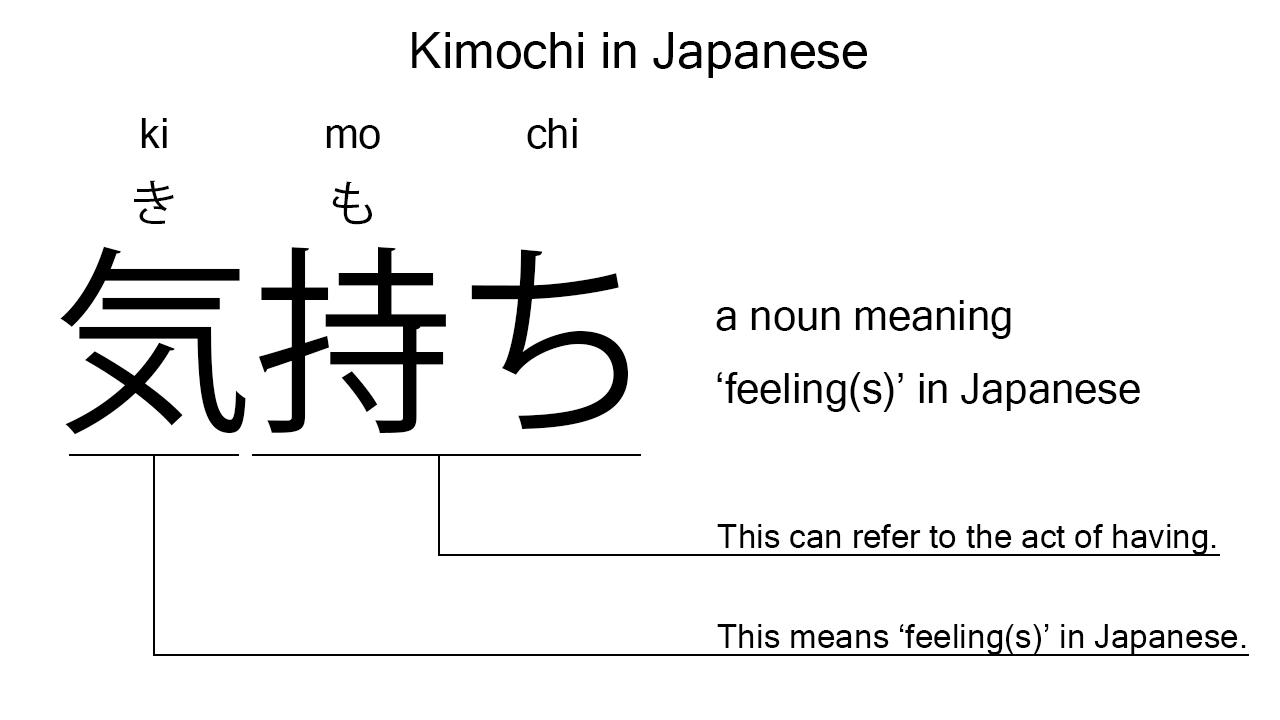What does “kimochi” mean in Japanese?
Native speakers say “kimochi” often to mean ‘feeling’ in Japanese. Perhaps, some Japanese learners know this word as it is sometimes used in Japanese movies, songs, novels, manga, anime, and the like. In this blog post, however, I will explain this word in detail based on its grammatical components. And also, I will explain how to use it through example sentences. My explanations would help Japanese learners understand “kimochi” more clearly. Then, let’s get started!
Contents
Definition and meanings of “kimochi”
Let me start with the definition and meanings of “kimochi”.
- kimochi – 気持ち (きもち) : a noun meaning ‘feeling’, ‘mind’, ‘heart’, or such in Japanese. This can also work as plural. Learn more about Japanese plural.
Native speakers use this noun to refer to someone’s feeling, mind, heart, or such in Japanese. So, this is very similar to the English nouns written above.
The definition and meanings are not that difficult. To understand this noun more clearly, however, let me explain its grammatical components in detail, one by one.
What does “kimochi” literally mean in Japanese?
“Kimochi” consists of the following two components:
- ki – 気 (き) : a noun widely used to mean ‘mood’, ‘mind’, ‘feeling’, or such in Japanese.
- mochi – 持ち (もち) : one conjugation of the verb, “motsu”, which means ‘to have’ in Japanese.
These two components tell us that “kimochi” literally means ‘a feeling which someone has in their mind’ in Japanese. This literal interpretation is very close to the actual meanings.

When we meet new Japanese words, we should check their grammatical components in detail to understand their meanings clearly and deeply. In many cases, components tell us a lot about the meanings of the words they form. Actually, here, we could get the better understanding of “kimochi” through the detailed check above.
So far, I’ve explained the definition and meanings of “kimochi” together with its grammatical components. Then, let me explain how to use it through the example sentences below.
Example #1: how to say “feelings” in Japanese
kanojo wa watashi no kimochi wo shira nai – 彼女は私の気持ちを知らない (かのじょはわたしのきもちをしらない)
She doesn’t know my feelings.
Below are the new words used in the example sentence.
- kanojo – 彼女 (かのじょ) : a pronoun meaning ‘she’ in Japanese.
- wa – は : a binding particle working as a case marker or topic marker. In the example, this works after “kanojo” to make the subject in the sentence.
- watashi – 私 (わたし) : a pronoun meaning ‘I’ in Japanese.
- no – の : a case particle used after a noun or pronoun to make its possessive case. In the example, this is used after “watashi” to make its possessive case, “watashi no“, which means ‘my’ in Japanese.
- wo – を : a case particle used to make the object word in a sentence. In the example, this is used after “watashi no kimochi” to make the object in the sentence.
- shira – 知ら (しら) : one conjugation of the verb, “shiru”, which means ‘to know’ in Japanese. In the example, it has been conjugated for the better connection with its following word.
- nai – ない : an auxiliary verb used after a verb, adjective, or auxiliary verb to deny its meaning. In the example, this is used after “shira” to deny its meaning.
This is a typical usage of “kimochi”. In this example, it works together with the possessive case, “watashi no”, to say “my feelings” in Japanese. Native speakers sometimes use this combination.
Example #2: another usage of “kimochi”
boku no kimochi wo kangae te kudasai – 僕の気持ちを考えてください (ぼくのきもちをかんがえてください)
Please think about my feelings.
Below are the new words used in the example sentence.
- boku – 僕 (ぼく) : a pronoun meaning ‘I’ in Japanese. This is used mainly by boys and young males. In the example, this works together with the case particle, “no”, to mean ‘my’ in Japanese.
- kangae – 考え (かんがえ) : one conjugation of the verb, “kangaeru“, which means ‘to think’ in Japanese. In the example, it has been conjugated for the better connection with its following word.
- te – て : a conjunctive particle used after a verb, adjective, or auxiliary verb to make its te form. In the example, this is used after “kangae” to make its te form, “kangae te”. Verbs need to be changed to their te forms to be connected with “kudasai”.
- kudasai – ください : one conjugation of the verb, “kudasaru”, which means ‘to give’ or such in Japanese. When this follows a verb, however, this can work like an auxiliary verb to add the meaning of ‘please’ in Japanese. In the example, this works like an auxiliary verb after “kangae te” to add the meaning of ‘please’.
This is another typical usage of “kimochi”. In this example, it works together with the possessive case, “boku no”, to mean ‘my feelings’ in Japanese. When we want to say “feelings” in Japanese, anyway, “kimochi” is a good option.
Summary
In this blog post, I’ve explained the definition and meanings of “kimochi” in detail based on its grammatical components. And also, I’ve explained how to use it through the example sentences. Let me summarize them as follows.
- kimochi – 気持ち (きもち) : a noun meaning ‘feeling’, ‘mind’, ‘heart’, or such in Japanese. This can also work as plural. This noun consists of two components, “ki” and “mochi”, which literally mean ‘a feeling which someone has in their mind’ in Japanese. This literal interpretation is very close to the actual meanings.
Hope my explanations are understandable and helpful for Japanese learners.